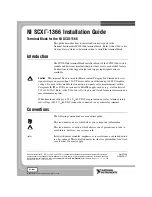
ORCA-50 UHF Demo Manual V1.0
17 Eximia Srl
–
www.eximia.it
- www.rfidstore.it
◆
The starting frequency must be less than or equal to the end frequency.
◆
Set the starting frequency and end frequency to the same frequency. The reader will work at constant
frequency.
This parameter is set, the reader's RF carrier will be in the restricted frequency range of random
frequency hopping.
The default RF spectrum specification is FCC (902MHz - 928MHz)
。
Method 2: user-defined reader spectrum.
The user uses three parameters to define the spectrum: the starting frequency, the frequency interval,
the number of frequency points
。
Note: In order to improve the anti-jamming performance, American Standard and European standard
frequency band equipment selected hardware is different, it can not meet the compatible American
standard, the European standard two bands
。
1.5.3 Set the antenna connection to receive
Antenna connection to receive the function is: read and write tags before checking whether the port is
connected to the antenna, if not connected, then notify the user antenna is not connected.
Before using the user to open this function, through the interface shown below to view, set the
interface of this function as shown below
:
The sensitivity of the antenna detection is set by the user. Antenna detection sensitivity is the antenna
port return loss value (Return Loss), the unit is dB. The greater the value, the better the impedance matching
between the antenna and the port. In general, a normal antenna can set this threshold to 3 - 6 dB. Ceramic
antenna or handset antenna can reduce the sensitivity lower. If the return loss threshold is set to 0, it means
that this function is disabled and the status of the antenna connection will not be detected before reading
and writing the tag.
If the antenna is not connected, read and write tags when the operation will return to the antenna is
not connected to the error message
。
1.5.4 Measure the return loss of the current antenna port
The return loss of the antenna port is detected at the interface shown below
:




































